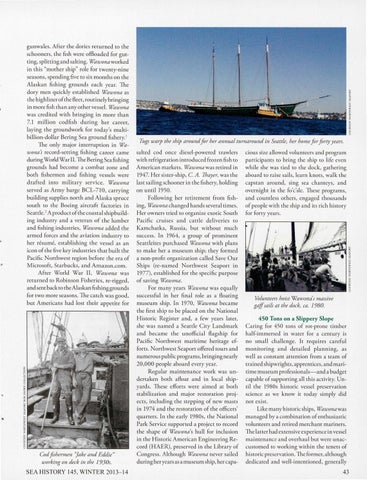gunwales. Afrer the dories returned to the schooners, the fish were offioaded for gucring, spliningandsalring. Wawonaworked in this "mocher ship" ro le for twenty-nine seasons, spending five to six months on the Alaskan fishing grounds each year. The dory men quickly established Wawona as rhe highliner of rhe Beer, routinely bringing in more fish than any other vessel. Wawona was credited with bringing in more than 7. 1 million codfish during her career, laying the groundwork for today's multibillion-dollar Bering Sea ground fishery.1 The o nly major interruption in Wawona's record-se tting fishing career came during World War II. The Bering Sea fishing grounds had become a combat zone and both fishermen and fishing vessels were drafred into military service. Wawona served as Army barge BCL-7 10, carrying building supplies north and A laska spruce south to the Boeing aircrafr factories in Searde. 2 A product of the coastal shipbuilding industry and a veteran of rhe lumber and fishing industries, Wawona added rhe armed forces and the aviation industry to her resume, establishing the vessel as an icon of the five key industries that built the Pacific Nort hwest region before rhe era of Microsofr, Starbucks, and Amazon.com. Afrer Wo rld War II, Wawona was returned to Robinson Fisheries, re-rigged, and sent back to the Alaskan fish ing grounds for rwo more seasons. The catch was good, bur Americans had lost their appetite for
Cod fishermen "fake and Eddie" working on deck in the 1930s.
SEA HISTORY 145, WINTER 20 13- 14
Tugs warp the ship around for her annual turnaround in Seattle, her home for forty years. salted cod once diesel-powered trawlers w ith refrigeration introduced frozen fish to American markers. Wawona was retired in 1947. Her sister-ship, C. A. Thayer, was the last sailing schooner in the fishery, holding on until 1950. Following her retirement from fishing, Wawona changed hands several rimes. Her owners tried to organize exotic South Pacific cruises a nd carde deliveries to Kamchatka, Russia, bur witho ut much success. In 1964, a gro up of prominent Seard eites pu rchased Wawona with plans to make her a museum ship; they formed a non-profit organ ization called Save Our Sh ips (re- named Northwest Seaport in 1977), established for the specific purpose of savi ng Wawona. For m any yea rs Wawona was equally successful in her final role as a Boating museum ship. In 1970, Wawona became the first ship to be placed on the National Historic Register and, a few years later, she was named a Searde City Landmark and became the unofficial flagship for Pacific Northwest maritime heritage efforts. Northwest Seaport offered tours and numerous public programs, bringing nearly 20,000 people aboard every year. Regular maintenance work was undertaken both afloat and in local shipyards. These efforts were aimed at both stabilization a nd major restoration projects, including the stepping of new masts in 1974 and the restoration of the officers' quarters. In the early 1980s, the National Park Service supported a project to record the sh ape of Wawona's hull for inclusion in rhe Historic American Engineering Record (HAER), preserved in the Library of Congress. Although Wawona never sailed during her years as a museum ship, her capa-
cious size allowed volunteers and program participants to bring rhe ship to life even while she was tied to the dock, gatheri ng aboard to raise sai ls, learn knots, walk the capstan arou nd, sing sea chanteys, and overnight in rhe fo'c's le. Th ese programs, and countless others, engaged thousands of people with the ship and its rich history for forty years.
Volunteers hoist Wawona's massive gaffsails at the dock, ca. 1980.
450 Tons on a Slippery Slope Caring for 450 tons of rot-prone timber half-immersed in water for a century is no small challenge. It requires careful monitoring and derailed planning, as well as constant anention from a ream of trained shipwrights, apprentices, and maritime museum professionals-and a budget capable of supporting all this activity. Until the 1980s historic vessel preservation science as we know it today simply did nor exist. Like many historic ships, Wawona was managed by a combination of enthusi as tic volunteers and retired merchant mariners. The laner had extensive experience in vessel m aintenance and overh aul buc were unaccustomed to working within the tenets of hi storic preservation. The former, although dedicated and well-intentioned, generally
43
